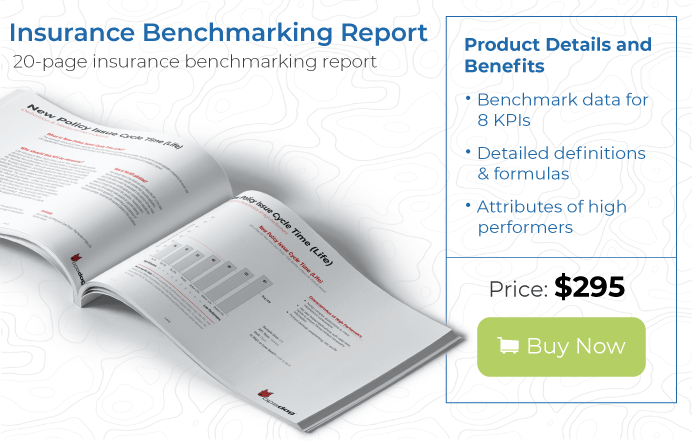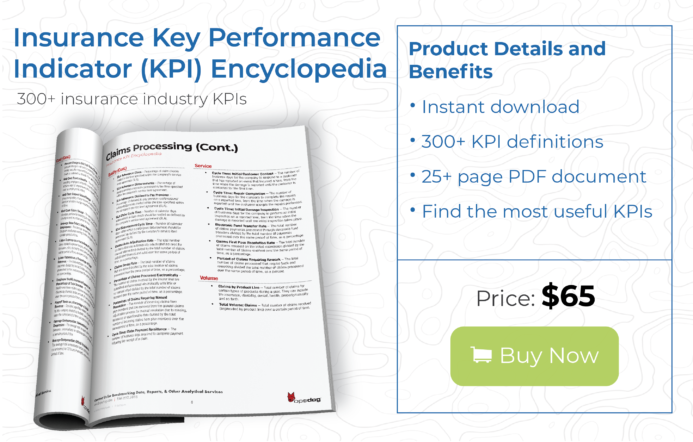Claims is where the rubber meets the road. For auto insurers, paying legitimate claims while minimizing the costs to process those claims is critical to profitability. Learn to benchmark auto insurance metrics to boost claims productivity and streamline operations. Auto insurance metrics enable insurers to determine how to control claims costs without negatively impacting customer satisfaction.
What are Auto Insurance Benchmarks?
To benchmark auto insurance, first you will need to pick metrics to measure. Insurers can use both key performance indicators (KPI) and key risk indicators (KRI) for claims benchmarking. KPIs describe the operational efficiency of claims processing and KRIs describe the risks associated with not collecting more premiums than insurers pay out in claims.
Once you have chosen metrics that align with your insurance company’s goals, then you are ready to begin to benchmark in earnest. An auto insurance benchmark can be defined as a point of reference, either a KPI or KRI or other chosen insurance metric, against which performance is compared against an industry average to gauge where your business lands that can be used to pin-point problem processes or areas.
There are a wide variety of benchmarks available for auto insurers to compare how their costs compare to their peers. Administrative benchmarks that measure the number of new policies booked or the speed of underwriting are important in monitoring revenues, while claims benchmarks ensure that revenue isn’t unnecessarily leaked from the bottom line.
Benefits of Using Benchmarks in the Auto Insurance Industry
Insurers obviously have to pay bona fide claims but how efficiently they pay those claims directly impacts profitability. Insurers can control some elements of claims management and settlement, such as how productive and accurate claims adjusters are and how long it takes to process claims. Claims that take months to resolve—or claims that need to be re-estimated—cost the insurer more than claims handled expediently.
Other problems that affect the bottom line include mistakes made by less-experienced claims adjusters, too many manual processes, and too many adjusters for the number of claims. If you benchmark auto insurance metrics, it becomes easier to pick out what issues are plaguing the claims department and plan helpful solutions.
If a claim is made and the auto insurer’s policyholder is not at fault, the insurer can recover costs from the at-fault party. How quickly and how successfully insurers are able to subrogate these claims affects profitability as well.
Since auto insurance is a highly transactional business, it’s relatively easy to measure productivity even down to the individual employee level. There are lots of questions that auto insurance industry benchmarks can answer:
- Do we have the right staffing levels in our claims processing areas?
- How productive are our adjusters?
- Do our adjusters need additional training?
- Can we improve claims processing efficiency by re-tooling our workflows?
- Do we need to standardize our claims process?
- Are we prioritizing claims properly?
Efficient claims processing is good for the auto insurer not just for reducing operating costs. Policyholders judge insurers by how quickly and fairly they process claims. Delays, or unacceptable claims estimates, reflect badly on the insurer and can cost the insurer loyal customers.
Auto Insurance Benchmark Examples
Depending on their business model and overall strategy, auto insurers can select from a wide variety of industry benchmarks. Here are five metrics often-used to benchmark auto insurance, which are focused on claims processing:
Auto Insurance Benchmark #1: Subrogation Referral Rate
Insurance companies rely on subrogation to recover costs from the at-fault party for funds paid, including customer deductibles. Not being able to recover these costs can have a significant impact on an insurer’s profitability. Ideally, insurers want a high subrogation referral rate, meaning that they are actively seeing reimbursement. Those insurers with a low subrogation rate should evaluate their subrogation guidelines to make sure they are not leaving money on the table.
To calculate this metric, divide the number of claims referred to subrogation by the total number of paid claims, as a percentage.
Auto Insurance Benchmark #2: Subrogation Recovery Rate as a Percentage of Total Loss
Similar to the above metric, monitoring the subrogation recovery rate helps auto insurers determine if they are missing out on potential revenue by not pursuing reimbursement of paid claims. Insurers that are able to recover a higher percentage of losses can pass those savings on to their policyholders.
This metric measures the success of subrogation attempts by dividing the dollar amount recovered through subrogation by the dollar amount paid in losses, as a percentage. In addition to inefficient subrogation processes, a low recovery rate could mean that the risk profile of policyholders is too high.
Auto Insurance Benchmark #3: New Claims Per Adjuster
To reduce operating and staffing costs—and improve policyholder satisfaction—auto insurers strive to improve the productivity of their claims adjusters. By dividing the number of new claims opened by the number of adjusters, auto insurance companies can get a handle on productivity.
There are several reasons that new claims per adjusters can be low. The auto insurer may have too many adjusters and should consider reducing staffing levels. They should also look at whether or not adjusters are adequately trained or if the claims adjusting process is inefficient.
Auto Insurance Benchmark #4: Supplemental Cost as a Percentage of Repair Cost
Auto insurers rely on their adjusters to put a price tag on the damage caused to a policyholder’s vehicle. Depending on the extent of the damage and the value of the car, an appraiser can “total” the car. However, damages assessment is not always a simple calculation and relies on adjuster expertise. Not estimating the appropriate claim amount fairly leads to upset and frustrated customers.
Over or under-estimated repair costs can indicate that adjusters need additional training or the company needs to institute a more standardized damage assessment checklist. To calculate this metric, divide the dollar amount of supplements paid to claimants by the dollar amount of repair costs, as a percentage.
Auto Insurance Benchmark #5: Percentage of Claims with Supplements
This metric also measures the accuracy of claim adjuster damage estimates but considers number of claims instead of dollar amount. If adjusters don’t create accurate estimates, they cause more work for their policyholders, repair shops, and the insurer itself. If the initial estimate of damages is not enough to cover the extra repair work, the adjuster probably has to make a return trip to reassess damages.
To calculate, divide the number of paid insurance claims that require a supplement by the number of total claims, as a percentage.
Final Thoughts
Auto insurance company profitability is largely governed by the number of policies sold and premiums collected (as well as money invested) versus the amount paid out in claims. Companies that benchmark auto insurance metrics can reduce claim processing costs by improving productivity and accuracy as well as recouping monies from subrogation, which positively impacts the bottom line.
Are you tasked with reducing and minimizing insurance claims leakage? Find out how to accelerate those efforts here!
For a full list of auto industry and other related insurance benchmarks, download our Insurance Benchmarking Report here.
If you require additional assistance in developing an inventory to benchmark auto insurance metrics then you may find our Insurance Key Performance Indicator Encyclopedia helpful. For even more information on our Benchmarking Research and business intelligence implementation services, contact us here. OpsDog can help your insurance company build a benchmark plan and provide you with presentation-ready, high-quality deliverables.



